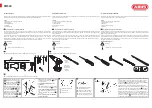
5
Maintain tools with care.
Keep tools sharp and clean for better and safer performance. Follow
instructions for lubricating and changing accessories. Inspect tool cords periodically and, if damaged,
have them repaired by an authorized technician. The handl;es must be kept clean, dry, and free from
oil and grase at all times.
Disconnect power.
Unplug tool when not in use.
Remove adjusting keys and wrenches.
Check that keys and adjustment wrenches are removed
from the welder and work area before plugging in.
Avoid starting unintentionally.
Be sure the switch is in the off position when not in use and
before plugging in. Do not carry any tool with your finger on the trigger, whether it is plugged in or
not.
Stay alert.
Watch what you are doing. Use common sense. Do not operate any tool when tired.
Check for damaged parts.
Before using any tool, any part that appears damaged should be
carefully checked to determine that it would operate properly and perform its intended function.
Check for alignment and binding of moving parts; any broken parts or mounting fixtures; and any
other condition that may affect proper operation. Any part that is damaged should be properly repaired
or replaced by a qualified technician. Do not use the tool if any switch does not turn on and off
properly.
Guard against electric shock.
Prevent body contact with grounded surfaces such as pipes,
radiators, ranges, and refrigerator enclosures.
Replacement parts and accessories.
When servicing, use only identical replacement parts. Use
of any other parts will void warranty. Only use accessories intended for use with this welder.
Approved accessories are available from www.uwelding.com.
Do not operate tool if under the influence of alcohol or drugs.
Read warning labels on
prescriptions to determine if your judgment or reflexes are impaired while taking drugs. If there is any
doubt, do not operate the welder.
Maintenance.
For your safety, service and maintenance should be performed regularly by a
qualified technician.
Use proper size and type extension cord.
If an extension cord is required, it must be of the
proper size and type to supply the correct current to the welder without heating up. Otherwise, the
extension cord could melt and catch fire, or cause electrical damage to the welder. This welder
requires use of an extension cord of 20 amps minimum capability up to 30 feet, with a wire size rated
at 12 AWG. Longer extension cords require larger size wire. If you are using the welder outdoors, use
an extension cord rated for outdoor use, signified by “WA” on the jacket. Performance of this welder
may vary depending on condition in local line voltage. Extension cord usage may also affect welder
performance.
The warnings, cautions and instructions discussed in this instruction manual cannot cover all
possible conditions and situations that may occur. It must be understood, by the operator, that
common sense and caution are factors, which cannot be built into this product, but must be
supplied by the operator.
ARC WELDER SAFETY WARNINGS AND PRECAUTIONS
Warning: This product, when used for welding and similar applications, produces chemicals to
cause cancer and birth defects (or other reproductive harm).






































